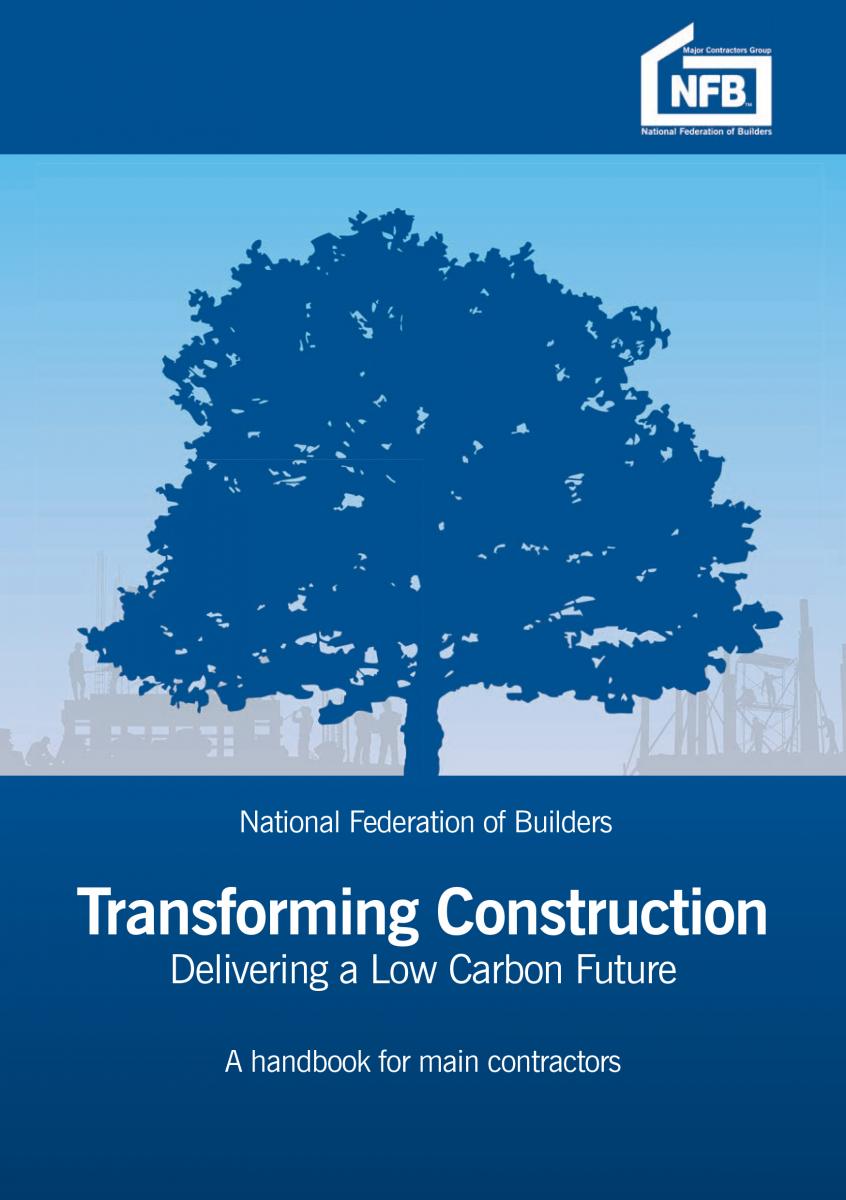The National Federation of Builders’ Major Contractors Group has armed main contractors with practical tools for accelerating a move towards achieving net zero carbon with the publication of a handbook, Transforming Construction: Delivering a Low Carbon Future.
The handbook was launched by Mark Wakeford, Chair of the Major Contractors Group (MCG), at the NFB’s Large Contractors Forum on 2 December.
It develops the MCG’s report, Transforming Construction for a Low Carbon Future, that was published in November last year. The new handbook offers a clear and practical route map to help deliver a low carbon future.
According to the 2019 Global Status Report for Buildings and Construction released by the Global Alliance for Buildings & Construction (Global ABC) at the COP25 UN climate conference in Madrid in December 2019, 39% of human energy-related greenhouse gas emissions are from buildings and the construction sector.
Clearly, then, a net zero contribution from construction and the buildings the industry erects has the potential to make a significant impact on reducing the amount of greenhouse gasses human activity releases into the atmosphere.
Nearly a quarter of the CO2 produced by the construction industry comes from making the cement used in concrete. Much of the rest comes from heating and cooling the buildings over their lifetimes once they are occupied, so a major aim is to design buildings that need the least possible amount of heating and cooling.
The cement producers are also working hard to reduce the amount of CO2 they release into the atmosphere with projects like the world's first full-scale carbon capture & storage facility at a HeidelbergCement plant in Brevik, Norway. It is due to open in 2024.
Most building product companies are working on reducing the encapsulated carbon content of their products as well as designing products that will make buildings more energy efficient in use.
In the introduction to the Major Contractors Group’s 40pp handbook, Mark Wakeford, Chair of the Group, says: “While the Covid-19 situation undoubtedly presents a significant immediate risk to us all, few would argue about the momentous threat that climate change presents to all our futures.”
The handbook aims to give major contractors the tools they need to start or to accelerate their decarbonisation journey by presenting a range of actions in a staged process that can be adopted and implemented by any company, at whatever stage it has reached in its decarbonisation.
The Decarbonisation Accountability Checklist from Transforming Construction – Delivering a Low Crabon Future:
- Appoint a carbon-change maker at Senior Management Team or Board level to drive the agenda
- Set a carbon reduction ambition or goal
- Develop a carbon-leadership team, consider a cross-section of employees and departments
- Develop a company-wide Carbon-Reduction Strategy with measurable targets and KPIs
- Establish achievable benchmarks in the early years of implementation
- Ensure recognition when key milestones hit
- Incorporate training into the relevant levels (strategic, management, project management)
- Consider appointing external consultants to manage transformation or planning processes.
In a Ministerial Forward to the handbook, Gillian Keegan, the Government Minister for Apprenticeships & Skills, says: “This report is a welcome step in the right direction, acting as a handbook for main contractors on how to decarbonise their businesses and their supply chains.
“As we look ahead to the UK co-hosting the Climate Ambition Summit for world leaders at COP26 next year, I encourage everyone to engage with this report as they travel on their own decarbonisation journeys.”
COP26, the 26th United Nations Climate Change Conference, is due to take place in November this year at the Scottish Event Campus (SEC) in Glasgow. It had originally been scheduled for November last year but fell foul of the coronavirus.
While reducing the encapsulated carbon content of products might be seen as a sensible cost cutting exercise by reducing the amount of energy used in the production of goods, products that help the energy efficiency of a finished building are quite often not the least expensive products available for the build.
Even reducing the encapsulated carbon of products does not necessarily mean a saving in energy costs in their manufacture – the carbon capture & storage facility at HeidelbergCement’s Brevik plant will do nothing to reduce production costs and is expected to cost 12.9billion Krone (more than £1billion) to build and a similar amount to run for a decade. It is why the Norwegan tax payers are picking up nearly all the cost rather than the company.
If a reduction in CO2 emissions over the lifetime of a building, from planning to demolition, is seen as a priority by society, then it is hard to see how a model of free market profit maximisation at a company level is going to achieve it. There will have to be legislation demanding the use of products conforming to certain standards and construction methods and they will have to be policed.
Some restrictions already exist in construction through Building Regulations, of course, but we have seen how effective they sometimes are with disasters such as Grenfell Tower. It would also be interesting actually to measure the ‘U’-value of the envelopes of completed buildings, especially, perhaps, houses.
Nevertheless, whatever obstacles have to be overcome, the aim will no doubt be achieved (if it is achieved) through a number of incremental steps and the Major Contractors Group handbook Transforming Construction – Delivering a Low Carbon Future is one of those steps.
As well as suggesting steps to take, the handbook features case studies from businesses at various stages of decarbonisation. One of the companies furthest along the route is Skanska, which has implemented full carbon accounting and is certified to PAS 2080, a standard for whole-life carbon management in infrastructure.
Skanska can accurately assess the amount of CO2 (equivalent) gases emitted for each £1million of its revenue. It reduced it from 351tonnes in 2010 to 215tonnes by 2018. It aims to get it down to 130tonnes per £1million of revenue by 2030 and to achieve zero carbon by 2045.


